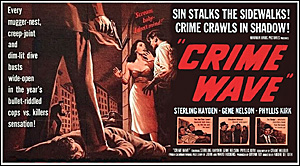December 2017
Monthly Archive
Fri 15 Dec 2017
Posted by Steve under
Reviews[9] Comments

BILL CRIDER – Murder Among the OWLS. St. Martin’s Press, hardcover, 2007. Worldwide, paperback, January 2008.
OWLS in this case is spelled correctly. It’s an acronym for Old Women’s Literary Society, an organization in Clearview Texas of which the murder victim in this book was a member, the book being the 14th of what is currently 23 novels in Bill Crider’s Sheriff Dan Rhodes series of low-key and semi-homespun mysteries.
He’s actually the sheriff of Blacklin County. I’m not sure if Clearview is the county seat or not, but it’s where both Rhodes and Helen Harris live, close enough that when she is killed in her own home, her cat wanders off and ends up at Rhodes’ back door, to the consternation of at least one of the Rhodes’s two dogs.
And while trying to find Mrs. Harris’s killer, Rhodes also finds himself trying to find a new home for “Sam” as Ivy (Mrs. Rhodes) has already renamed him. If this makes Murder Among the OWLS sound like a cozy to you, I’d have to agree with you, but it’s one with a bit of an edge to it. While pursuing his sheriffing duties, Rhodes does meet up with a man with a gun (and earlier on, an angry man with a working chain saw).
But Murder Among the OWLS is also a detective puzzle, and a good one, well-clued but with the clues hidden well enough that with only ten pages to go, Rhodes still doesn’t know who the killer is. In those ten pages. though, a lot of things he’s noticed in his investigation finally come together, just as they should.
Most importantly, though, in makes this book a “fun read” — there’s no other way to put it — are the people that Rhodes meets along the way, new ones as well as those he’s already friends and neighbors with. No fancy rich folks among them, no fancy talk, but people you can recognize and relate to, even the killer — ones you might meet in your own home town or neighborhood, unless you’re a millionaire and travel in circles that I never will, whether you’re from Texas or not.
UPDATE. 15 December 2017. This review first appeared on this blog on 19 November 2015. It has been reposted here today as part of a massive tribute to Bill Crider as part of Patti Abbott’s weekly Friday’s Forgotten Books posts. Follow the link to an Internet-wide collection of reviews of Bill’s books and thoughts and memories of him. He recently has had to give up his own blog and entered hospice care. I’ve known Bill through fanzines, letters and email for something like 40 years, and it doesn’t seem nearly long enough.
Thu 14 Dec 2017
REVIEWED BY DAVID VINEYARD:

A GENTLEMAN AFTER DARK. United Artists, 1942. Brian Donlevy, Miriam Hopkins, Preston Foster, Harold Huber, Philip Reed, Gloria Holden, Douglas Dumbrille. Screenplay by Patterson McNutt & George Bruce, based on the story “A Whiff of Heliotrope†by Richard Washburn Child. Directed by Edward L. Marin.
An old-fashioned melodrama of the crook-with-a-heart-of-gold type, served like a Brut of chilled champagne with a top cast, and a solid screenplay co written by pulp master and screenwriter George Bruce.
Harry Melton (Brian Donlevy), is a master thief, a guy who always knows the angles, who leaves a sprig of heliotrope behind as his signature on all this crimes. Suave, debonair and impeccable, Harry is on top of the world on New Year’s 1923, having just pulled off a daring heist, and becoming the father of a baby daughter with adored wife Flo (Miriam Hopkins).

Things seem almost too good to be true, or so his partner and friend Stubby (Harold Huber) warns, and he could be right, because Harry’s old pal and adversary Captain Tom Gaynor (Preston Foster) of the NYPD is hot on his heels this time, and seems to know a lot more than usual.
That might be because Flo and Eddie (Philip Reed), another member of the gang, are double crossing Harry and setting him up so they can abscond with the $50,000 necklace Harry just stole.
Harry makes short work of the two, sending them packing, but losing Flo broke him, and what kind of life can he provide his newly born daughter?

So Harry makes a deal with Tom. Tom will collect the reward for the jewels and Harry, adopt his daughter and raise her as his own, and Harry will go to prison for the rest of his life.
Twenty years later, Tom is a respectable state Supreme Court Justice and his daughter has just gotten engaged to marry the soldier son and scion of the Rutherford’s (William Prince) American royalty. Harry, when Stubby visits him in prison to update him, could not be happier.
Then he finds out Flo is back in the country, and with sleazy lawyer Douglas Dumbrille is plotting to blackmail Tom, and ruin their daughter if he doesn’t pay.
What can Harry do but bust out and set things straight?

This all depends on the playing, and few actresses could master really unpleasant the way Miriam Hopkins did. There was always an edge to her screen persona, a bite that meant you seldom just accepted her as good or bad, but saw the nuances. She seemed to use sex more manipulatively than Harlow’s tough little not so bad girls or Davis early too self-aware sex kittens.
There were brains under Hopkins’ blonde curls, and in some parts the soul of a rabid wolf. You could almost root for her at the same time you were hoping someone would shoot her.
She seemed to enjoy being bad on screen more than most.
Donlevy, well what can you say? He was ideal for this kind of role, and played a thousand variations on it, always the genial, tough, slightly sarcastic, over confident, sometimes good bad guy, sometimes likable bad guy, with forays into brute and psychotic. He could deliver a line with a sneer as well as any mustache twirling silent villain or save himself with a knowing humble grin.

Granted he didn’t always bother to act as much as he might have, but then too, he always seemed to know when in a role he could chew effectively. This era was probably the high point of his career and he knows he has the audience with him here.
Foster had more range than he usually got to show, and here has a pretty thankless role as a good guy who is Harry’s conscience and better angel. He does it well, just as Huber brings a little heart to his cliched role.
Maybe that’s why I like A Gentleman After Dark so much, because it was exactly what it wanted to be, never overplayed or overwritten. It tells the story without asking you to make too many judgments, and keeps the Damon Runyon/Boston Blackie style sentiment well-iced, thanks to Donlevy’s real menace in some scenes and Hopkins soulless self interest.
Thu 14 Dec 2017

TRESPASS. Universal Pictures, 1992. Bill Paxton, Ice-T, William Sadler, Ice Cube, Art Evans, De’voreaux White, Bruce A. Young. Director: Walter Hill.
There are movies that grow on you. Movies that seem only so-so while you’re watching them for the first time, but as the days go on, you start thinking more and more about what you saw — the characters and the scenes they played and appreciating them — but it’s only when you look back that you begin to realize how well they may have been done.

And then there are, on the other side of the coin, movies that you enjoyed immensely while you were watching hem, but when it comes time to writing up your thoughts about them as I am now, you can’t find anything to say about it. Not a single scene sticks out. Just a general sense of solid film-making, you think, but — how solid could it have been if there’s nothing there that makes you want to tell other people about it?

Here’s the basic plot line. Two semi-redneck firemen from Arkansas, both white, come up to a deserted factory in East St. Louis and a cache of gold hidden there for years. Unknown to them, it’s also the site of a gangland execution, which by chance, at the right place at the wrong time, they happen to witness.

And once seen, all chaos breaks out. Luckily for them, they have a hostage — the younger brother of the leader of the gang. Lots of fire power ensues. Lots. This is an action thriller par excellence. But not an iota of characterization. None. The only performance I remember is that of Art Evans, an actor whose name I did not know before, who plays a elderly black squatter in the factory, comically caught between the two warring factions.
End of review.
Wed 13 Dec 2017
REVIEWED BY WALTER ALBERT:

BLUE, WHITE AND PERFECT. 20th Century Fox, 1941. Lloyd Nolan (PI Michael Shayne), Mary Beth Hughes, Helene Reynolds, George Reeves, Steven Geray. Based on the character created by Brett Halliday and a story by Borden Chase (see comments for more information). Director: Herbert I. Leeds. Shown at Cinevent 26, Columbus OH, May 1994.
In addition to Chandu (reviewed here ), I was also looking forward to a film I remembered with great pleasure from ts original release, Blue, White and Perfect.

Lloyd Nolan is a wise-cracking Michael Shayne hired to follow the trail of industrial diamonds hijacked from an aircraft factory. This crime comedy of international war-time intrigue finds him on a liner bound for Honolulu where he teams up with George Reeves (as “Juan Arturo O’Hara”), an FBI Investigator traveling incognito to continue the investigation. Shayne is a fast talker and situation improvisor, and Nolan is fine in this role, although the film was not as fleet of foot as I remembered it.
After the convention as I was watching The Shadow in another film as he was on the point of drowning in a chamber filling with water, I recalled the scene in Blue where Nolan and Reeves are trapped in a baggage compartment by a bad guy. A similar ploy taken from the matinee chapter-play thriller, the room in which the walls are closing in was effective in Star Wars and demonstrates the continuing reliance of movies on their history.
With delectable Mary Beth Hughes as Shayne’s long-suffering girl friend.
Tue 12 Dec 2017
Posted by Steve under
Reviews[12] Comments
FRANCES CRANE – The Golden Box. Pat Abbott & Jean Holly #2. J. B. Lippincott, hardcover, 1942. Popular Library #80, paperback, no date stated, circa 1946. Rue Morgue Press, softcover, 2005.

This second of a series of 26 crime-solving adventures of husband-and-wife (to be) takes place in Jean Holly’s home town of Elm Hill, Illinois, not in New Mexico, where she has been living ever since her parents died. She is single, but at the age of 26, she is starting to wonder how she will manage the rest of her life as an old maid. Her future husband, a private detective named Patrick Abbott, is in the picture, though, and part of the fun of this book is in watching how their somewhat bumpy romance is progressing.
But from Jean’s point of view only. Pat Abbott is one of those strong, quiet kind of men, and getting him to say more than a couple of words about the case at a time, for example, is a bit of a struggle. What he thinks about Jean is another matter altogether — there we have no idea — but that he is in Illinois where Jean’s Aunt Sue is recovering from a short illness should tell you something.

Dead is the rich old lady who runs just about everything in terms of Elm Hill society matters, and she is pretty much disliked for that very same same reason. Domineering, you might say. Her death might have been passed off as natural if it weren’t for the followup death of the black maid who found her body — in her case a suicide that that doesn’t look like one, not to the trained eye of an expert like Pat Abbott.
The opening chapter is a bit of mess, with characters being introduced willy-nilly without very much of an introduction, and the ending is cluttered and confused. In between, though, the hometown sleuthing is fun to watch and goes down smoothly — there are lots of suspects!
While there is one good clue as to the killer’s identity, Pat Abbott otherwise keeps all his cards too close to his chest (see above). The motive for the killing is discovered, for example, only by sending a telegram off to his secretary back in his office for her most timely assistance.
Mon 11 Dec 2017
REVIEWED BY DAN STUMPF:
JOSEPH SHEARING – So Evil My Love. Harper & Brothers, US, hardcover, 1947. Pocket #560, paperback, 1948. Collier, paperback, 1961. First published in the UK by Hutchinson as For Her to See, hardcover, 1947. Film: Paramount, 1948. TV adaptation: Season 5, Episode 23 of Lux Video Theatre, 27 January 1955.

SO EVIL MY LOVE. Paramount, 1948. Ann Todd, Ray Milland, Geraldine Fitzgerald, Leo G. Carroll, Raymond Huntley. Screenplay by Ronald Millar, based on the novel by Joseph Shearing. Directed by Lewis Allen.
A rare example of a pretty good book enriched and improved by the Hollywood Treatment.
Marjorie Bowen (real name Mrs. Margaret Gabrielle Vere Long née Campbell) wrote about a hundred and fifty novels under a variety of pen names, but she reserved “Joseph Shearing†for books based on real-life crimes. This one is inspired by the mysterious death of Charles Bravo in 1876, referred to in the Press as “Murder in the Priory.â€
Briefly, Charles Bravo was poisoned by antimony and lingered in agony for three days without telling attending physicians how he came to ingest it. Two inquests were held, with heavy suspicion falling on his wife, but no one was ever charged.
The novel opens with Olivia Harwood, a missionary’s widow recently returned to London and in dire straits. She contacts Susan Courtney, an old school mate now rich but unhappily married to an abusive dullard. Because she has some foolish letters Susan once wrote about her love for another man, Olivia gets a position in the household as Susan’s paid companion.

Over the next couple hundred pages, she consolidates her power over Susan and makes enemies of everyone in the household. She also makes the acquaintance of Mark Bellis, a charming painter and obvious (to the reader) con man who talks Olivia into extorting and stealing from Susan, then absconds with the loot and the letters. By this point the relationships between the characters have gotten to the point where the only recourse for Olivia is to part Susan from her husband… permanently.
To her credit, Shearing/Bowen does a fine job ratcheting up the suspense, especially in the inquest scenes, and she’s equally skillful at relating things from Olivia’s POV and letting us see what she’s missing. Overall though, the book suffers in comparison to the film.

Probably because they wanted to protect the image of their stars, Paramount and writer Ronald Millar changed the dynamics between the characters considerably, and in the process made them deeper and more complex. In the book, Olivia is motivated by greed and envy, but in the film Ann Todd is a loyal friend to Susan (A brilliant performance from Geraldine Fitzgerald) who is corrupted by Ray Milland and genuinely torn when she sees her old friend charged with murder and realizes she has done this to her.
For his part, Milland imparts his equivocal charm to the Mark Bellis character, who doesn’t come in till well into the book, but shows up early in the film. Even better, the more he corrupts Olivia, the more he finds himself genuinely drawn to her. And as the two characters pursue their passion, it leads to a richly ironic conclusion that eerily recalls Letter from an Unknown Woman or Duel in the Sun in its satisfying tragedy.

Director Lewis Allen puts all this across with typical Paramount polish and a measured pace perfectly suited to the material. He also steps back and gives his supporting players plenty of room to strut their stuff. I’ve already mentioned Geraldine Fitzgerald, but she deserves another nod for the way she moves her character from vapid cheer to despairing near-madness. Raymond Huntley plays the nasty husband as a perfect prick, but with a faint trace of sympathy that makes him more believable. Even stuffy Leo G. Carroll lends a touch of roguishness to his role as a cynical PI who moves the story to its conclusion.
In sum, this is a film that departs considerably from its source, but one you shouldn’t miss.
Sun 10 Dec 2017
Posted by Steve under
Reviews[7] Comments
REVIEWED BY DAVID VINEYARD:
ALISTAIR MacLEAN – Night Without End. Collins, K, hardcover, 1960. Doubleday, US, hardcover, 1960. Reprint editions include: Fawcett Gold Medal, US, paperback, no date stated [1960s], among many others, both US and UK.

In latitude 72.40 north, 8000 feet up on the Greenland ice-cap, self-preservation makes for a remarkable turn of speed.
That’s an understatement to say the least in Alistair MacLean’s Arctic thriller, Night Without End, that opens as the team at an IGY tracking station in the bitter north hears a plane where none should be, and one in trouble at that, a jet airliner circling above their lonely station, in trouble in the sky, and about to come down in an unforgiving land.
Dr. Mason, the narrator, and his two companions know what the Arctic can do to the unwary, the unprepared. They know routine, food, shelter, warmth, and common sense are life and anything less is death.
At his best, and this was written in his best period before his work became little more than screen scenarios, no one could drop you into the middle of a pulse-pounding plot with the same elan as the Scottish author of adventure classics like The Guns of Navarone and Ice Station Zebra. He seemed, too, to have a fine ear for the detail of Arctic adventure, for the ice prick pain of the bitter cold and the soul destroying chill no protective gear can fully repel.

If he lacked the Conradian or Stevensonian skills of a Hammond Innes or Geoffrey Household or the sheer gift for character of a Victor Canning and humor of a Desmond Bagley, he made up for it with driving narrative, impeccable research, and an eye for plot that Agatha Christie might have admired, for his best works tend, like a classic Christie tale, to set a small group of people in an isolated environment with a mystery to be solved whose solution is as vital to everyone’s survival as the natural world that threatens from without.
As with Ice Station Zebra, the McGuffin in this one is only important to set the action in motion, but that’s more than enough, this is about action, suspense, mystery, and thrills, not the history of a plot contrivance.
Here it turns out the cause of the plane coming down was no accident. It was hijacked and forced down, and it’s 18,000 miles off course.

No one knows who the hijackers are, why they did it, or if they survived, but they have committed one murder other than the passengers killed in the crash, and they are willing to commit more, and only Mason can uncover their plot, stop their sabotage, and keep his crew and the survivors alive as the weather deteriorates and the endless night closes in while outside human threats accumulate, including the good guys who will do anything to stop the killer escaping and the bad guys set to rendezvous with him and leave everyone else to die.
The tense finale on a shifting glacier is as satisfying as it is nerve wracking.
Night Without End is one of MacLean’s tighter plotted and leaner books, with just the right mix of action, atmosphere, weather, characterization, plot, and twists to keep you happily turning pages and wishing that someone today still had the skills to write this kind of book with the same economy. An old favorite, and I was both pleased with how well it holds up, but also how much of it I remembered considering I first read it back in Middle School.
This night has an end, and a very satisfactory one it is.
Sun 10 Dec 2017
Posted by Steve under
Reviews[2] Comments
REVIEWED BY JONATHAN LEWIS:
MICHAEL CONNELLY – Echo Park. Harry Bosch #12. Hachette, hardcover, 2006; paperback, August 2007.

What struck me most about Echo Park, a Michael Connelly thriller, was how well it captured the geography of Los Angeles and Burbank, two cities I am very familiar with. It’s that sense of place, that gritty urban realism, which makes this entry in Connelly’s Harry Bosch police detective series a worthwhile read. That’s not to say that’s it’s not a good thriller in and of itself. It is. It’s just that that the geography and topography featured in the work is, to my mind anyway, just as important as plot and character.
For those not familiar with Harry Bosch, he’s Connelly’s best known fictional creation, a Vietnam veteran turned LAPD detective, the type of guy who plays by his own rules and has his own particular code of honor. In this twelfth book in the series, his code of honor makes him dogged in his pursuit of justice for the murder of Marie Gesto, a young woman who disappeared in 1993. Flash forward to 2006 and Bosch still hasn’t put anyone behind bars for the crime, and he hasn’t been able to deliver closure to the poor girl’s parents in Bakersfield.
Through luck or something far more sinister, Bosch learns that a serial killer by the name of Raynard Waits is willing to confess to the murder of Marie Gesto. But there’s something off about this strange man’s willingness to confess to the crime. He wasn’t even on Bosch’s radar in 1993. Bosch had always thought that the son of a wealthy LA businessman was the likely culprit. Echo Park follows Bosch as he navigates not only Los Angeles, but also the byzantine internal politics of the LAPD. Along the way we meet a sleazy lawyer, an ambitious prosecutor, an FBI agent who may be in love with Bosch, and a coterie of police officers.
I found Echo Park to be an engrossing read, what some critics would consider the hallmark of a successful work of commercial fiction. What the novel lacks in depth, it more than makes up for in forcing the reader to discover what comes next. However, when all was said and done, I can’t say that I found the villains in the work to be particularly compelling. But the geography and sense of place certainly are. This is a work of Los Angeles crime fiction par excellence.
Sat 9 Dec 2017
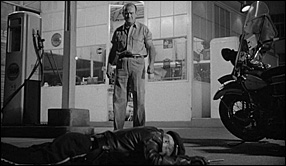
CRIME WAVE. Warner Brothers, 1953. Sterling Hayden, Gene Nelson, Phyllis Kirk, Ted de Corsia, Charles Bronson (as Charles Buchinsky), Jay Novello, Ned Young, Dub Taylor. Director: André De Toth.
Here’s a relatively unknown film noir that I recently saw for the first time, and if you haven’t seen it, it’s one I’m pleased to recommend to you without a single reservation. Or if you have seen it but not recently, why not watch it again? It’s one of those films that you see more of it every time you watch it.
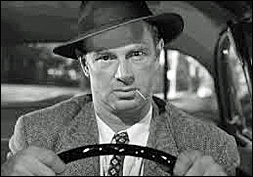
It isn’t much of a crime wave. A small gang of ex-cons are pulling a small series of gas station robberies. The police assume that they’re only after eating money, as the take they get is never more than a few hundred dollars. But when their latest job costs the life of a motorcycle cop who stops to investigate, the attitude of the police changes dramatically, starting with Det. Lt. Sims, played by Sterling Hayden, who towers majestically over everyone, laconically shooting out his dialogue in torrents, tommy-gun fashion.
Caught in between the police and the holdup gang is Gene Nelson and his wife, Phyllis Kirk. He’s out on parole, has a good job, and wants nothing to do with his former cell mates, but when they invade his home and hold his wife hostage, he has no choice to go along with them, and the plan they’re working on next.
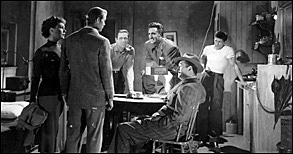
The movie has filmed in only 13 days, and mostly on location in the greater Los Angeles area, giving the film a sense of immediacy that it might not otherwise have.
On a personal level, Lt Sims is adamantly against the idea of parole — once a con always a con — and to me this is Starling Hayden’s movie all the way. Gene Nelson does his best, but standing up against this hulking nemesis of a police officer? No way, no how.
Even if the ending is a little rushed (and all does end well), as a well-photographed crime thriller, that, well — go back and read my first paragraph again.
Fri 8 Dec 2017
Posted by Steve under
Reviews[2] Comments
REVIEWED BY BARRY GARDNER:
JEROME DOOLITTLE – Half Nelson. Tom Bethany #5. Pocket, hardcover, 1994; paperback, 1995.
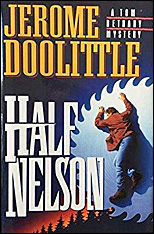
I missed the fourth of Doolitttle’s tales of would-have-been-Olympic-wrestler-except-for-Carter’s-boycott, ex-pilot, now sort of PI Bethany, but fortunately these don’t require reading in strict sequence.
Bethany is at a Harvard gathering as his lover Hope’s request, to meet with a save-the-trees environmentalist who has received death threats by mail. He’s not able to help the man much, who flies back to Oregon to go about his business. When shots are fired at his house there, however, Bethany packs up and heads West to see what he can do.
The situation worsens drastically, and before it’s done Bethany is head-to-head against both Big Business and the FBI, and there have been more deaths than one.
I like Doolittle’s writing, and I like the not-in-the-data-banks character of Bethany, so I like the books. I have a weakness for one-man-against-the-system (damn, there’s a lot of hyphens in this review) stories, and that’s basically what these always are.
Doolittle is a good storyteller. What I don’t like is the unrelentingly liberal bias against business and authority in any form. Life just isn’t that simple, Jerome, however comforting it might be to think so. It’s still a damned good read, though.
— Reprinted from Ah Sweet Mysteries #14, August 1994.
Editorial Comment: My review of Body Scissors, the first of the Tom Bethany books, appears here. There were six in the series in all. A complete list follows that earlier review.
« Previous Page — Next Page »




